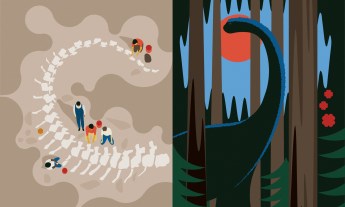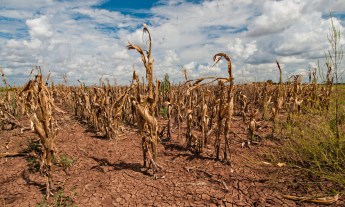
TED science curator David Biello exposes the odd couple behind the de-extinction movement: scientists and hunters. What does this say about our ambivalent attitude toward animals?
Our world is the setting of a great murder mystery: Where did all the big animals go? Although Earth is the scene of the crime for many deaths — it is estimated that 99 percent of organisms that have ever lived are extinct — roughly 35,000 years ago something unique happened: Most of the big animals disappeared from almost every continent. Australia’s giant wombats and kangaroos, as well as the marsupial wolf, were the first to fall, dying roughly 50,000 years ago. Over the next 10,000 years, most of the big mammals of Eurasia, including the vegetarian cave bear and the woolly mammoth, vanished. By 35,000 years ago, the murderer — whoever or whatever it was — struck North America, which saw the last of its mastodons and saber-toothed tigers dwindle and disappear.
There is one suspect who showed up on the scene time and time again just as the big animals start their march toward extinction: us. Homo sapiens arrives in Australia by 40,000 years ago at the latest. It takes a bit longer for us to spread out across the world’s biggest continent, Eurasia, but once we do, big animals soon disappear. There isn’t much sign of us in North America 35,000 years ago when big animals started to decline, but archaeological sites keep being found that extend our arrival further and further back in time. So while correlation is not causation, the story happens again and again and again. People come, big animals go. We are the charismatic megafauna — and, really, what animal can be as charming and cute as a human child? — that kills other charismatic megafauna: mammoth, mastodon, saber-toothed tiger, giant beaver and giant kangaroo.
Now humans could have the opportunity to make up for our past blunders.
New technology in genetics may allow us, for the first time, to bring back extinct species by using ancient DNA and splicing or cloning it. Miss the mammoth? Find some of its DNA frozen in the tundra, and scientists just might be able to resurrect it. At a special TEDx event held in 2013 devoted to bringing back dead fauna, a warning flashed on a screen before the talks began. It showed a big picture of a woolly mammoth with the words “Don’t make me come get you; turn off your cell phone.” That is the fervent wish of one group of scientists and dreamers, to live in a world where a mammoth could corner you and put you in your place. The mammoth has become the poster species for this effort, which has been dubbed de-extinction.
George Church, who stands tall at nearly two meters in height and sports a longish white beard, looks like Leonardo da Vinci’s picture of God. The Harvard Medical School professor is perhaps the most prominent proponent of synthetic biology — the human manipulation of the very stuff of life, the genetic code. Inspired by the 1964 World’s Fair in Queens, which was famed for its Futurama depiction of the near future, he took up biology rather than redesigning cars or building robots. His fundamental aim was simple: Bring the tools and techniques of engineering to biology and unleash a world where cells could be remade to do people’s bidding, whether for curing disease or churning out fuels to replace gasoline. In the lab at Harvard where he oversees 90 students, one experiment stands out: Asian elephant cells reconfigured to come closer to those of a woolly mammoth. As the longtime innovator says, “The best way to predict the future is to change it.”
The change Church would like to see is mammoth roaming Siberia, or perhaps even Neanderthals reborn from human mothers. But such a resurrection will take more than scientific know-how (and it will require a great deal of that; at least eight Nobel Prize-worthy breakthroughs are necessary), it will also require desire, the desire to see such animals anew. And the people with the greatest desire to see a woolly mammoth again are the modern-day descendants of the hunters that may have helped speed its doom, people who want to resurrect a long-extinct species just so they can take it down with a gun.
The human instinct to hunt may be the last thing saving big mammals — or bringing back extinct ones.
Hunters are the original conservationists and remain responsible for the majority of wilderness and wildlife protection the world over. Wetlands International protects unloved marshes for their value to duck hunters; the American bison was saved from slaughter by a captive-breeding program at the Bronx Zoo so that it could be hunted; and the auctioning off of a license to hunt an endangered white rhino raised money to preserve its fellows (as well as the ire of strict preservationists). This kind of ambivalent relationship to wildlife is likely to be a hallmark of the Anthropocene, a proposed new epoch in geologic time that reflects the many enduring impacts of humans on the planet. Some people will be dedicated to preserving or bringing back certain animals or plants. Others will be equally dedicated to killing them.
Those involved in de-extinction tend to see their work as part of a tradition of humans as gardeners –only now we’re gardeners of the whole planet, picking and choosing which plants and animals get to survive and thrive. This does not mean that humans are in charge of evolution. “We can’t say we’re in control if we don’t know what we’re doing,” says Beth Shapiro, a professor and paleogenomics researcher at University of California, Santa Cruz.
But in the wider world, people and their choices certainly set the parameters under which evolution operates: climate, habitable zones, selection pressure and the like.
Today, scientists weigh whether to use genetic engineering to rid the world of the mosquitoes that spread malaria and other deadly diseases. That would be a calculated extinction, purposeful and once reserved for viruses like smallpox, which live on only in their own frozen arks in the bowels of medical facilities. For desirable species that are not yet extinct but at risk, there’s always assisted evolution: humans helping direct the process of natural selection by culling individuals with low heat tolerance, say, or breeding individuals from farther south with those farther north to promote beneficial gene flow. A lot of weird, wild, wacky stuff will be tried, as much as human ingenuity can devise.
The world is in a triage situation in the Anthropocene. Tough decisions will have to be made about what species to save outright, what species to save for later by freezing genetic data that may come in handy, and what species to, with due respect, allow to perish, as has been the norm on this ever-changing planet for billions of years. When experimenting with an extinct species, at least the pressure is off and there is no urgency. The worst has already happened. So even if efforts to bring back the mammoth ultimately fail, it does not fail to inspire people to dream of a different world.
Excerpted with permission from The Unnatural World: The Race to Remake Civilization in Earth’s Newest Age (Scribner/Simon & Schuster, 2016) by David Biello. Copyright © 2016 by David Biello.












